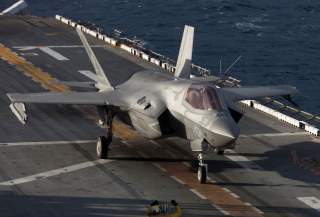The Story of How China Could Sink the U.S. Navy in a War
Bad news.
The challenge as presented above is simple: “math wins.” Even assuming a hit-to-kill ration of 100% by Allied missile defenses, Chinese planners need to simply have more missiles on hand while only having to come close to allied forces in an effort to expend their missile interceptors. Chinese forces could also employ another method—saving advanced ASBM and cruise missiles that might be more accurate for later while first employing older missiles that might not be as accurate as “bait” for U.S. missile defenses. After such interceptors are exhausted, Chinese forces could use more advanced and highly accurate missiles in an effort to overwhelm possible U.S. capital ships and force their withdrawal from combat operations or presumably suffer massive casualties.
Mines
While we all love to talk about those sexy high-tech weapons of warfare, there are many older types of technology that can be just as deadly. While it might not get a lot of attention, China does have a tremendous amount of sea mines. Leveraged in various capacities, especially in a Taiwan crisis, they could pose tremendous problems for the U.S. Navy or other allied powers. Don’t take my word for it, Andrew Erickson, Lyle Goldstein & William Murray, in what I would consider the most comprehensive study on Chinese mine warfare explain that:
...Chinese mine warfare (MIW) represents a dynamic and ambitious sector within a PLAN that is plainly making rapid strides toward modernization. It demonstrates that China’s MIW draws extensively on the assimilated lessons of foreign experiences, as well as a surprisingly rich and relevant indigenous history.
China’s mine inventory is not only extensive but likely contains some of the world’s most lethal MIW systems. Indeed, China is on the cutting edge of mine warfare technology and concept development, and it already fields systems that advanced nations—the United States, for one—do not have in their arsenals. PLA strategists understand the human dimension of modern warfare, and this is evident in Chinese MIW. Indeed, Chinese naval periodicals reveal an increasingly impressive training regimen, one that goes beyond rote, scripted exercises. ...Chinese MIW doctrine that emphasizes speed, psychology, obfuscation, a mix of old and new technologies, a variety of deployment methods—and that additionally targets very specific U.S. Navy platforms and doctrines.
...Chinese MIW is noteworthy because it is one of a few warfare areas that could, in conjunction with other capabilities, suddenly and completely upset the balance of power in the western Pacific. Taiwan’s mine countermeasure-ships (MCM) force is minimal and could be destroyed in preemptive strikes. Japan’s MCM fleet is robust, but Tokyo remains a major “wild card” politically in a cross-strait conflict. Most fundamentally, U.S. and allied MCM forces are not sized or configured to “fight their way in” by operating in areas in which sea and air control are contested. Even in uncontested waters, MCM forces make operationally significant changes only slowly. Accordingly, Chinese MIW represents a point of major leverage for Beijing…
Concluding Thoughts:
Combined with challenges below the waves that are just now being understood, the U.S. Navy must keep in mind a number of A2/AD platforms that will have to be factored into its operational and strategic planning in the near term. Efforts over the last several years like Air-Sea Battle (now JAM-GCC) demonstrate that America’s armed forces, and specifically Navy, are more than up to the task. However, with the challenge of sequester still looming over the horizon questions remain if America’s military can drive the innovation needed to stay ahead of the curve (think things like the 3rd offset strategy). Will the technology and weapons platforms needed to stay ahead be funded adequately? It stands to reason we will find out soon enough.
Harry J. Kazianis serves as Editor of RealClearDefense, a member of the RealClearPolitics family of websites. Mr. Kazianis is also a non-resident Senior Fellow for Defense Policy at the Center for the National Interest and a non-resident Senior Fellow at the China Policy Institute (non-resident). He is the former Executive Editor of The National Interest and former Editor of The Diplomat. Follow him (or yell at him) on Twitter: @grecianformula.
Image: Flickr

